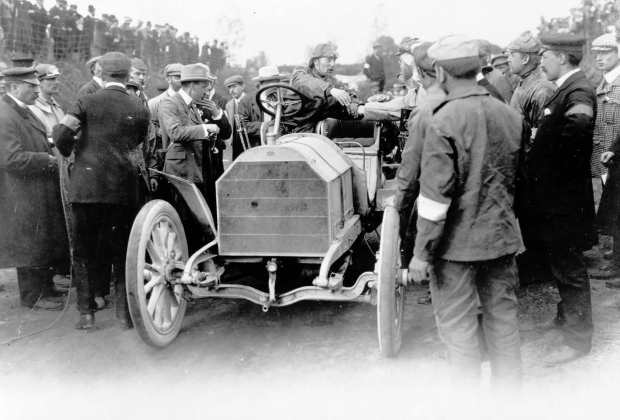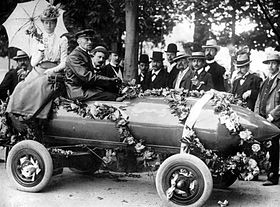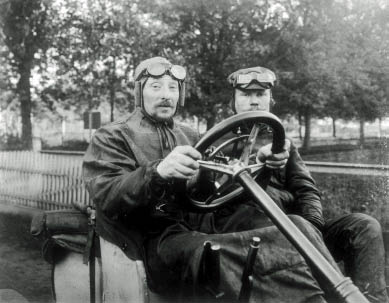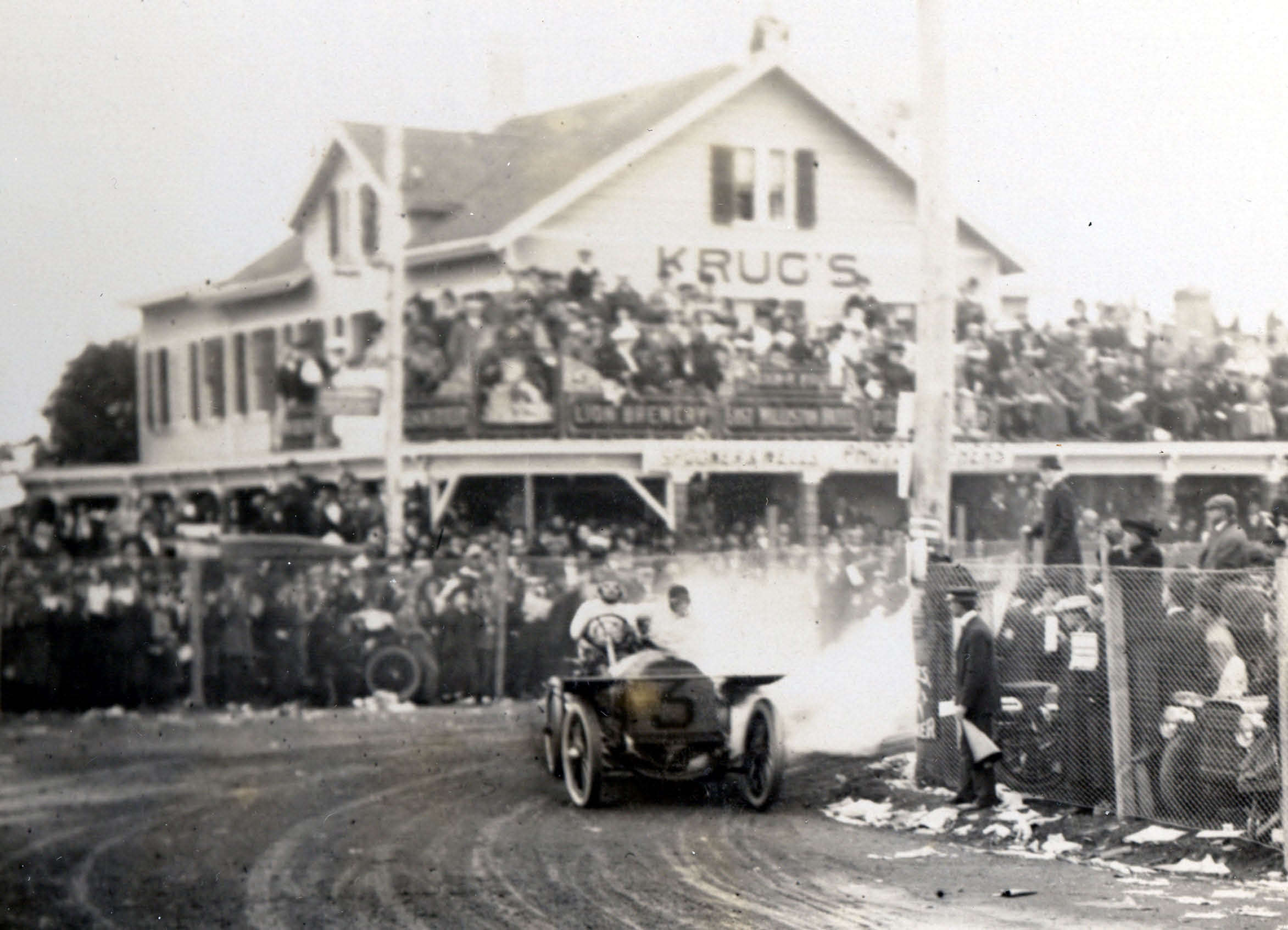Driver Profile: Camille Jenatzy- “The Red Devil” and His Tragic Death

A Belgian race car diver, Janatzy broke the land speed record three times and was the first man to break the 100 km/hr barrier. He was nicknamed Le Diabo Rouge ("The Red Devil") for his color of his beard.
From uniquecatsandparts.com/au
He Had 9 Lives, But A Practical Joke Proved Fatal
CAMILLE JENATZY, BORN IN 1865, was a Belgian civil engineer turned motor manufacturer who made his competition debut in 1898 at the controls of one of his own electric vehicles, in the Chanteloup hill-climb organised by La Prance Automobile.
Although heavy rain had affected the road surface, Jenatzy made the fastest time of the day, covering the 1800-metre course at an average speed of 17 mph. Three weeks after this, on 18th December, La Prance Automobile held a second speed trial, this time over a standing-start, two-kilometre course on a deserted stretch of level road at Acheres, to the west of Paris.
Jenatzy could not take part, and the event was won by the Count Gaston de Chasseloup-Laubat driving an electric car built by Jeantaud, Jenatzy's manufacturing rival. The following day, Jenatzy wrote to Chasseloup-Laubat challenging him to a duel of speed, to be held within the month.
So, on the 17th January 1899, the two men met at Acheres. Jenatzy recorded a speed of 41.4 mph, but Chasseloup-Laubat clocked 43.7 mph, despite having the motor of his car burn out 200 yards from the finish. Ten days later, there was a return match. This time, Jenatzy reached 50mph over the flying kilometre, but Chasseloup-Laubat's motor burned out before he had even started. So his run was postponed until 4 March, when the Jeantaud achieved 57.6 mph.
The Jamais Contente
This was a phenomenal speed for the period, all the more remarkable for the fact that Chasseloup-Laubat's car was a standard touring vehicle fitted with a special body. Not in the least discouraged, Jenatzy set about building a new car with the express purpose of regaining the speed record. This was the famous Jamais Contente, a wonderful metal torpedo on wheels which was the first real purpose built racing car ever.
Its bullet-shaped body was made by Rheims & Auscher and was of partinium, a primitive aluminium alloy. To eliminate friction losses in the transmission, the electric motor was mounted directly on the driving axle. As a result, the car was fitted with the smallest wheels and tyres yet seen.
The First Vehicle To Exceed 100 Kph
 The low, streamlined effect was somewhat nullified by" the fact that Jenatzy had to sit on top of the body, with only his nether regions inside the cockpit; nevertheless, after one false start, the car achieved his ambition of being the first vehicle to exceed 100 kph, his actual figure being 105 kph (65.8 mph). Not everyone was impressed, though. W. Worby Beaumont wrote in his massive Motor Vehicles and Motors: 'This is without doubt a higher speed than any other human being has ever travelled on roads, but it was only for about three-quarters of a mile that it was maintained. This vehicle was of no use in any way as a guide for any other class of vehicle'.
The low, streamlined effect was somewhat nullified by" the fact that Jenatzy had to sit on top of the body, with only his nether regions inside the cockpit; nevertheless, after one false start, the car achieved his ambition of being the first vehicle to exceed 100 kph, his actual figure being 105 kph (65.8 mph). Not everyone was impressed, though. W. Worby Beaumont wrote in his massive Motor Vehicles and Motors: 'This is without doubt a higher speed than any other human being has ever travelled on roads, but it was only for about three-quarters of a mile that it was maintained. This vehicle was of no use in any way as a guide for any other class of vehicle'.
Because of the extremely limited range of the battery electric vehicle, especially if it was to have any sort of speed, Jenatzy soon turned his attention to petrol-electrics; he was also seen driving a Mors in three of the principal races of 1899 - the Tour de France, the Paris-St Malo and the Paris-Ostend - attracting public notice by his sporting effort in driving through the night in the Tour de France to make up for time lost.
In the 1900 Gordon Bennett, Jenatzy drove a Bolide petrol-electric of his own design, but lost his way and gave up in despair; the later Jenatzy petrol-electrics were equally unsuccessful, and his patent magnetic clutch, used by Pipe and Rochet-Schneider, enjoyed only a limited vogue. Jenatzy dropped out of motor sport during 1901, and his return in 1902 was hardly auspicious. During the Circuit des Ardennes, he had a terrible smash at the beginning of the second lap, the car going into one ditch and all four wheels into the other.
Le Diable Rouge
With his usual good fortune, he escaped with a few bruises. Because of his red hair and beard, and his flamboyant driving style, Jenatzy earned the nickname 'Le Diable Rouge' (The Red Devil), although there was nothing diabolic-apart from a liking for practical jokes-about his personality. In 1903, he transferred his allegiance to Mercedes, driving one of the. new 90 hp racers in the Paris-Madrid. Early in the race, he overtook 16 competitors, despite the unfavourable road conditions, and at Chatellerault, the big grey Mercedes was lying seventh. By Angoulerne, Jenatzy was third, and was being tipped as a possible winner but, at the top of the Petignac hill, he pulled up, with a mysterious fault in his engine. He eventually discovered, of all unlikely things, that the misfire was caused by a fly in the carburetter.
.
The Mercedes Team of Jenatzy, Baron de Caters and Foxhall Keene
 The literal "fly-in-the-ointment" cost him the race, as the delay had caused him to fall back into eleventh place, a position which he maintained until the race was halted at Bordeaux. Then came the Gordon Bennett, held in inland. A fire at the Mercedes factory having destroyed the special 90 hp models built for this race, the Mercedes team - Jenatzy, Baron de Caters and Foxhall Keene - used 60 hp tourers borrowed back from customers and fitted with racing bodywork.
The literal "fly-in-the-ointment" cost him the race, as the delay had caused him to fall back into eleventh place, a position which he maintained until the race was halted at Bordeaux. Then came the Gordon Bennett, held in inland. A fire at the Mercedes factory having destroyed the special 90 hp models built for this race, the Mercedes team - Jenatzy, Baron de Caters and Foxhall Keene - used 60 hp tourers borrowed back from customers and fitted with racing bodywork.
Ironically, as the two drivers chosen by Emil Jellinek (Werner and Heirony-mus) were not hochtaohlgeborene (of high birth), the Deutsche Automobil Club refused to allow them to compete, on social grounds - only gentlemen could take part in the Gordon Bennett, the honour of Germany was upheld by two Belgians and a Briton. From the second lap, Jenatzy, driving the wealthy American Clarence Gray Dinsmore's stripped Sixty Mercedes, led the field, and his victory by nearly 12 minutes brought the Gordon Bennett Cup back to Germany.
Jenatzy represented Germany in the 1904 Gordon Bennett, too, but was outclassed by Leon Thery's Richard-Brasier, and had to be content with second place. He reputedly had a narrow shave of epic proportions with a train at Wehrheim, where the line from Usingen to Frankfurt crossed the road, this was no mean achievement! A month later, for the Circuit des Ardennes, Jenatzy transferred his allegiance to the Belgian Pipe marque, but his 60 hp car only lasted two laps in this arduous race before breaking down.
The 1905 Gordon Bennett
In the 1905 Gordon Bennett, the Red Devil drove a 120 hp Mercedes, but although he made a spectacular start; the car only completed half the distance at an average speed of 40.5 mph. Having sworn to bring the Cup back to Germany whether he finished dead or alive, Jenatzy was somewhat embarrassed. Nor did he fare any better in the Circuit des Ardennes, where his Mercedes was forced out after a rim collapsed following the loss of its frail tyre.
 Jenatzy concluded an unsuccessful season by failing to finish in the Vanderbilt Cup, retiring on the fourth lap after dropping from second to sixth position in the preceding three rounds with the 120 hp Mercedes.
Jenatzy concluded an unsuccessful season by failing to finish in the Vanderbilt Cup, retiring on the fourth lap after dropping from second to sixth position in the preceding three rounds with the 120 hp Mercedes.
At the end of the first day's racing of the 1905 Gordon Bennett, he was lying 16th, having averaged 47.4mph, finishing well over two hours behind the leader, Szisz in a Renault. On the second day, he shared the car with Burton; the Mercedes started 16th and finished l0th, the first German car to complete the course.
 There was a tenth place for Jenatzy's Mercedes in the Circuit des Ardennes, too, while he came fifth in the Vanderbilt Cup that October. The race was stopped after he had finished, as the crowd had become uncontrollable, and hundreds of people were swarming on to the track. The next season saw jenatzy's Mercedes come 14th in the Kaiserpreis, but the combination failed to finish in the French Grand Prix, falling out on the eighth lap after working up through the field from 20th to 12th position.
There was a tenth place for Jenatzy's Mercedes in the Circuit des Ardennes, too, while he came fifth in the Vanderbilt Cup that October. The race was stopped after he had finished, as the crowd had become uncontrollable, and hundreds of people were swarming on to the track. The next season saw jenatzy's Mercedes come 14th in the Kaiserpreis, but the combination failed to finish in the French Grand Prix, falling out on the eighth lap after working up through the field from 20th to 12th position.
As in 1904, Jenatzy drove a Pipe in the Circuit des Ardennes. Again, the car failed to last the distance in the Belgian event. 1908 saw Jenatzy back with his original petrol-powered love, Mors. He drove a steady race to finish 16th at an average of 56.8 mph. However, both Mors and Jenatzy were past their prime, and this was the Red Devil's last appearance in international racing. He drove a 180 hp Mercedes in sprint and hill-climb events in 1909 and 1910, but thereafter devoted himself to his tyre company, whose factory in Brussels was one of the biggest in Belgium.
Death by Practical Joke
It was not Jenatzy's love of fast driving which caused his violent death in 1913, but his propensity for practical joking. He was entertaining a party of friends at his shooting box in the Ardennes, and one night decided to frighten them. Jenatzy crept outside, hid behind a bush, and imitated the fearsome grunt of an enraged wild boar. Whereupon one of his guests leaned out of the window and shot the supposed wild animal dead.
Links to related posts on VanderbiltCupRaces.com
Archives: 1905 Vanderbilt Cup Race, Long Island, New York
Archives: 1906 Vanderbilt Cup Race, Long Island, New York




Comments
I was wondering if the Stutz company had an entry in the Vanderbilt cup races
___________________________________________________________
Howard Kroplick
Roger, there were no Stutz entered in the Long Island Races (1904-1910). But , there were Stutz in the later races (1912-1916):
http://www.vanderbiltcupraces.com/blog/article/starting_lineup_the_1912_vanderbilt_cup_race_held_in_milwaukee
http://www.champcarstats.com/races/191401.htm
http://www.vanderbiltcupraces.com/blog/article/starting_lineup_the_1915_vanderbilt_cup_race_in_san_francisco
http://www.champcarstats.com/races/191613.htm